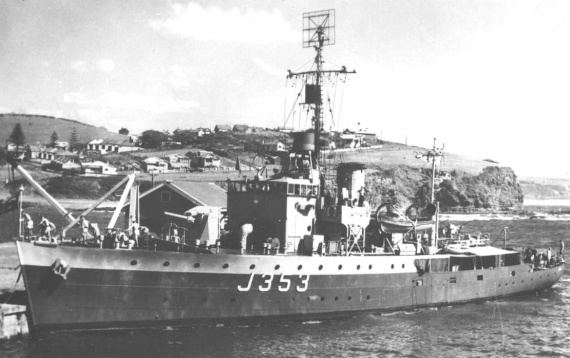HMAS Kiama
| Class |
Bathurst Class |
|---|---|
| Type |
Australian Minesweeper |
| Pennant |
J353, M353 |
| Builder |
Evans Deakin & Co Ltd, Brisbane |
| Laid Down |
2 November 1942 |
| Launched |
3 July 1943 |
| Launched by |
Mrs Lawson, wife of Minister for Transport |
| Commissioned |
26 January 1944 |
| Decommissioned |
3 April 1946 |
| Dimensions & Displacement | |
| Displacement | 650 tons |
| Length | 186 feet 2 inches |
| Beam | 31 feet |
| Draught | 8 feet 6 inches |
| Performance | |
| Speed | 15 knots |
| Complement | |
| Crew | 85 |
| Propulsion | |
| Machinery | Triple expansion, 2 shafts |
| Horsepower | 2000 |
| Armament | |
| Guns | 1 x 4-inch HA gun |
| Awards | |
| Battle Honours | |

HMAS Kiama was one of sixty Australian Minesweepers (commonly known as corvettes) built during World War II in Australian shipyards as part of the Commonwealth Government's wartime shipbuilding programme. Twenty were built on Admiralty order but manned and commissioned by the Royal Australian Navy. Thirty six (including Kiama) were built for the Royal Australian Navy and four for the Royal Indian Navy.
HMAS Kiama was laid down at Evans Deakin & Co Ltd, Brisbane, Queensland on 2 November 1942. She was launched on 3 July 1943 by Mrs Lawson, wife of the Minister for Transport and was the first RAN warship to carry the name of the NSW coastal town, 120 kilometres south of Sydney in the Illawarra region.
Kiama commissioned at Brisbane on 26 January 1944 under the command of Lieutenant Samuel J Bensen RANR(S).
Kiama began her operational wartime career in March 1944, when she arrived at Milne Bay for service in New Guinea waters. The first three months of duty were almost entirely occupied in escorting New Guinea coastal convoys. In June 1944, she was engaged on anti-submarine patrols in the Solomon Sea. In July 1944, New Guinea convoy duties were resumed.
In September 1944 Kiama was engaged in troop transport operations between New Guinea and New Britain and on the New Guinea coast. In October 1944 the escorting of convoys was resumed and continued almost without break to the end of the year. At the close of 1944, Kiama had with the exception of a brief visit to Cairns, served continuously in New Guinea waters for a period of more than eight months. During that time the ship steamed some 30,000 miles and was at sea for more than 3000 hours.
On 21 December 1944 Kiama arrived in Sydney. On Christmas Day the ship's company was recalled from leave to go to the assistance of the American ship Robert J Walker, which had been torpedoed and was sinking off the New South Wales coast. Anti-submarine patrols followed until the close of the year. On 3 January 1945 she reached Adelaide and commenced a period in refit.
Kiama resumed service in February 1945, arriving at Fremantle on the 14th of the month. She spent the next two months in Western Australian waters exercising with American submarines based at Fremantle.
On 7 May 1945 she arrived at Port Moresby to begin a further period of service in New Guinea waters. Later in May she carried out a series of coastal bombardments of eastern Buka Island and north eastern Bougainville areas. Bombardments of the same area were repeated in June 1945.
In July 1945 Kiama, at Torokina, embarked His Royal Highness The Duke of Gloucester for passage to Mutupina Point in the Solomon Islands. Later in the month she was troop carrying between Torokina and the Treasury Islands. At the close of July, she left New Guinea waters for Brisbane where she arrived on 5 August.
On 24 August 1945 Kiama returned to New Guinea waters and for the next five months was occupied with troop and store carrying, sweeping and general duties. On 29 January 1946 she arrived in Sydney and on paid off into Reserve on 3 April 1946. In her two years and two months of service Kiama steamed 60,882 miles and was underway for 6369 hours.
In May 1952, without again being brought into seagoing commission, Kiama was transferred to the Royal New Zealand Navy. She paid off from the Royal New Zealand Navy on 19 August 1976 for disposal.
Further reading
- The Corvettes: Forgotten Ships of the Royal Australian Navy, by Iris Nesdale - published by the author, October, 1982.
- Corvettes - Little Ships for Big Men, by Frank B Walker - published by Kingfisher Press, NSW, 1996.
- The Australian Centenary History of Defence Volume III, The Royal Australian Navy, edited by David Stevens, Oxford University Press, South Melbourne, Victoria, Australia, 2001.













